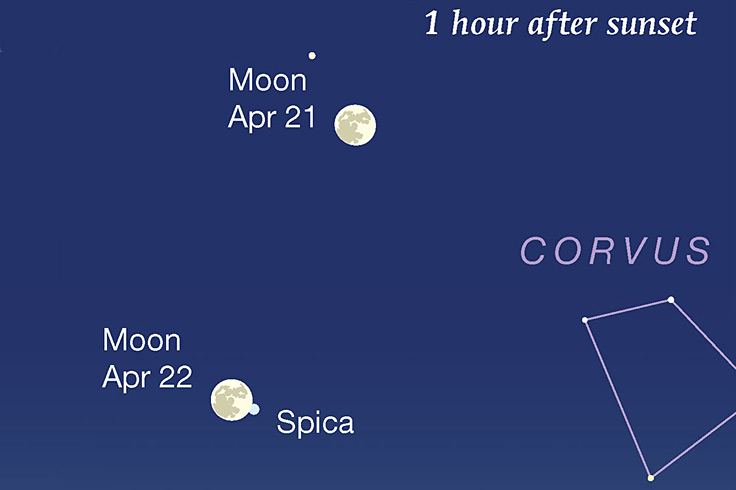
This Week's Sky at a Glance, April 26 – May 5
All the planets now huddle around our line of sight toward the Sun. However, these moonless evenings present us the Spring Triangle, the Great Diamond with a sugar sprinkle on its edge, and the Pointers aligned vertically.

This Week's Sky at a Glance, April 19 – 28
Springtime Leo walks high in the south, springtime Hydra snakes a quarter of the way around the celestial sphere, and the bright Moon aligns with Spica.

Explore the Night with Bob King
Jupiter Meets Uranus in Twilight; Supernova Erupts in Nearby Spiral Galaxy
Jupiter aligns with distant Uranus before it exits the evening sky as a bright supernova flares in the southern galaxy NGC 3621.

This Week's Sky at a Glance, April 12 – 21
Jupiter is easy to spot, shining low in the west at nightfall. Near it are Uranus and Comet Pons-Brooks, tougher catches that require binoculars or a wide-field telescope — and some finding skills.

This Week's Sky at a Glance, April 5 – 14
Venus and Jupiter may shine through the blue sky during the April 8th solar eclipse even if the eclipse for you is only deep partial. After dark, Orion walks down in the southwest.

April Podcast: Planets in Transition
April’s evening skies offer plenty of stars to check out. However, aside from Jupiter low in the west, planets are in short supply. Our latest Sky Tour podcast helps you track down Mars, Saturn, and much during April’s pleasant nights.

This Week's Sky at a Glance, March 29 – April 7
What? You say you're bored? The evening sky is moonless, the two Dog Stars align vertically, the Big Dipper dumps into the Little Dipper, and the Springs of the Gazelle cross the zenith.

Explore the Night with Bob King
What Will We See in the Sky During Totality?
Most of our time will be focused on Sun during the minutes of totality on April 8th, but consider tearing yourself away for a few seconds to put it all in context.
Partial: The Solar Eclipse for the Rest of Us
Whether the Sun will become a dented ball or an eerie crescent of fire, a celestial shadow show awaits you practically everywhere in North and Central America.

This Week's Sky at a Glance, March 22 – 31
The full Moon will go through a penumbral eclipse. Comet Pons-Brooks nears its best showing in early evening. And as Mercury fades in the sunset, Jupiter becomes the only easy planet in the entire sky.

Southern Stargazing with Jonathan Nally
The Stars of the Carina Constellation
Get to know the stars of Carina constellation — and learn how to spot the False Cross instead of being fooled by it!

This Week's Sky at a Glance, March 15 – 24
Mercury emerges in the sunset, far lower right of brighter Jupiter. And don't just arc to Arcturus and speed to Spica — continue the curve to Corvus, cruise to Capella, and more.

Explore the Night with Bob King
Is Betelgeuse Fading Again?
Betelgeuse has dipped nearly half a magnitude since late January. Could it be headed for another Great Dimming Event? We also take a look at this spring's "other" eclipse.

How to See the Diamond Ring Effect During a Total Solar Eclipse
Here's how to safely see the "diamond ring," the dazzling burst of sunlight seen just before and after totality.

This Week's Sky at a Glance, March 8 – 17
The Moon sidles up to bold Jupiter, then the delicate Pleiades, then the Castor and Pollux twins. Arcturus, ascending in the east, is probably the third-brightest star you've ever seen and that's including the Sun.

Astrophotography: Tips & Techniques
Como Fotografiar el Eclipse Con un Smartphone
Antes de intentar fotografiar el eclipse con su smartphone, lea el consejo de estos expertos.

Qué Buscar y Cuándo Durante un Eclipse Solar Total
Los fenómenos astronómicos y terrestres que no se debe perder durante el eclipse solar total del 8 de abril de 2024.

Meet Wezen, a Yellow Tail for a Big Dog
Wezen, a yellow supergiant more than 1,600 light-years from Earth, is also the tail of the Canis Major constellation.

This Week's Sky at a Glance, March 1 – 9
It's early March, so the Winter Triangle balances on Sirius after dark. The Gemini twins float high across the meridian. Leo jumps the gun on spring.

March Podcast: A Barely-There Lunar Eclipse
As told in the latest episode of our long-running Sky Tour astronomy podcast, this month it’ll be challenging to a special kind of lunar eclipse on March 25th — but easy to spot five of the 10 brightest stars in the night sky.
